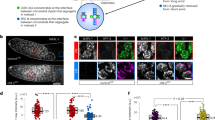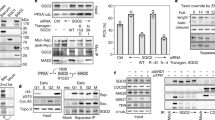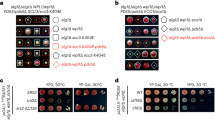Abstract
Cohesion between sister chromatids is established during DNA replication and depends on a protein complex called cohesin1,2,3,4,5,6,7. At the metaphase–anaphase transition in the yeast Saccharomyces cerevisiae, the ESP1-encoded protease separin cleaves SCC1, a subunit of cohesin with a relative molecular mass of 63,000 (Mr 63K)8. The resulting 33K carboxy-terminal fragment of SCC1 bears an amino-terminal arginine—a destabilizing residue in the N-end rule9. Here we show that the SCC1 fragment is short-lived (t1/2 ≈ 2 min), being degraded by the ubiquitin/proteasome-dependent N-end rule pathway. Overexpression of a long-lived derivative of the SCC1 fragment is lethal. In ubr1Δ cells, which lack the N-end rule pathway9, we found a highly increased frequency of chromosome loss. The bulk of increased chromosome loss in ubr1Δ cells is caused by metabolic stabilization of the ESP1-produced SCC1 fragment. This fragment is the first physiological substrate of the N-end rule pathway that is targeted through its N-terminal residue. A number of yeast proteins bear putative cleavage sites for the ESP1 separin, suggesting other physiological substrates and functions of the N-end rule pathway.
This is a preview of subscription content, access via your institution
Access options
Subscribe to this journal
Receive 51 print issues and online access
$199.00 per year
only $3.90 per issue
Buy this article
- Purchase on Springer Link
- Instant access to full article PDF
Prices may be subject to local taxes which are calculated during checkout



Similar content being viewed by others
References
Nasmyth, K., Peters, J. M. & Uhlmann, F. Splitting the chromosome: cutting the ties that bind sister chromatids. Science 288, 1379–1384 (2000).
Koshland, D. & Guacci, V. Sister chromatid cohesion: the beginning of a long and beautiful relationship. Curr. Opin. Cell Biol. 12, 297–301 (2000).
Yanagida, M. Cell cycle mechanisms of sister chromatid separation: roles of Cut1/separin and Cut2/securin. Genes Cells 5, 1–8 (2000).
Hirano, T. Chromosome cohesion, condensation, and separation. Annu. Rev. Biochem. 69, 115–144 (2000).
Dej, K. J. & Orr-Weaver, T. L. Separation anxiety at the centromere. Trends Cell Biol. 10, 392–399 (2000).
Pidoux, A. L. & Allshire, R. C. Centromeres: getting a grip of chromosomes. Curr. Opin. Cell Biol. 12, 308–319 (2000).
Biggins, S. & Murray, A. W. Sister chromatid cohesion in mitosis. Curr. Opin. Genet. Dev. 9, 230–236 (1999).
Uhlmann, F., Lottspeich, F. & Nasmyth, K. Sister-chromatid separation at anaphase onset is promoted by cleavage of the cohesin subunit Scc1. Nature 400, 37–42 (1999).
Varshavsky, A. The N-end rule: functions, mysteries, uses. Proc. Natl Acad. Sci. USA 93, 12142–12149 (1996).
Uhlmann, F., Wernic, D., Poupart, M.-A., Koonin, E. V. & Nasmyth, K. Cleavage of cohesin by the CD-clan protease separin triggers anaphase in yeast. Cell 103, 375–386 (2000).
Varshavsky, A. The ubiquitin system. Trends Biochem. Sci. 22, 383–387 (1997).
Hershko, A. & Ciechanover, A. The ubiquitin system. Annu. Rev. Biochem. 76, 425–479 (1998).
Bachmair, A., Finley, D. & Varshavsky, A. In vivo half-life of a protein is a function of its amino-terminal residue. Science 234, 179–186 (1986).
Suzuki, T. & Varshavsky, A. Degradation signals in the lysine-asparagine sequence space. EMBO J. 18, 6017–6026 (1999).
Xie, Y. & Varshavsky, A. The E2-E3 interaction in the N-end rule pathway: the RING-H2 finger of E3 is required for the synthesis of multiubiquitin chain. EMBO J. 18, 6832–6844 (1999).
Turner, G. C., Du, F. & Varshavsky, A. Peptides accelerate their uptake by activating a ubiquitin-dependent proteolytic pathway. Nature 405, 579–583 (2000).
Varshavsky, A. Ubiquitin fusion technique and its descendants. Methods Enzymol. 327, 578–593 (2000).
Turner, G. C. & Varshavsky, A. Detecting and measuring cotranslational protein degradation in vivo. Science 289, 2117–2120 (2000).
Spencer, F., Gerring, S. L., Connelly, C. & Hieter, P. Mitotic chromosome transmission fidelity mutants in Saccharomyces cerevisiae. Genetics 124, 237–249 (1990).
Buonomo, S. B. C. et al. Disjunction of homologous chromosomes in meiosis I depends on proteolytic cleavage of the meiotic cohesin Rec8 by separin. Cell 103, 387–398 (2000).
Tomonaga, T. et al. Characterization of fission yeast cohesin: essential anaphase proteolysis of Rad21 phosphorylated in the S phase. Genes Dev. 14, 2757–2770 (2000).
Mulder, L. C. F. & Muesing, M. A. Degradation of HIV-1 integrase by the N-end rule pathway. J. Biol. Chem. 275, 29749–29753 (2000).
Sijts, A. J., Pilip, I. & Pamer, E. G. The Listeria monocytogenes-secreted p60 protein is an N-end rule substrate in the cytosol of infected cells. Implications for major histocompatibility complex class I antigen processing of bacterial proteins. J. Biol. Chem. 272, 19261–19268 (1997).
Waizenegger, I. C., Hauf, S., Meinke, A. & Peters, J.-M. Two distinct pathways remove mammalian cohesin from chromosome arms in prophase and from centromeres in anaphase. Cell 103, 399–410 (2000).
Ghislain, M., Dohmen, R. J., Levy, F. & Varshavsky, A. Cdc48p interacts with Ufd3p, a WD repeat protein required for ubiquitin-mediated proteolysis in Saccharomyces cerevisiae. EMBO. J. 15, 4884–4899 (1996).
Mumberg, D., Muller, R. & Funk, M. Regulatable promoters of Saccharomyces cerevisiae—comparison of transcriptional activity and their use for heterologous expression. Nucleic Acids Res. 22, 5767–5768 (1994).
Acknowledgements
We are grateful to G. Turner, H.-R. Wang, F. Du, V. Ellison, A. Murray, D. Morgan, B. Stillman and P. Hieter for strains and plasmids. We thank M. Budd, W. Shuo and members of the Varshavsky laboratory, particularly F. Du and G. Turner, for helpful discussions. This work was supported by grants to A.V. from the NIH. H.R. is a Fellow of the Leukemia and Lymphoma Society. K.N. was supported by the Austrian Industrial Research Promotion Fund.
Author information
Authors and Affiliations
Corresponding author
Rights and permissions
About this article
Cite this article
Rao, H., Uhlmann, F., Nasmyth, K. et al. Degradation of a cohesin subunit by the N-end rule pathway is essential for chromosome stability. Nature 410, 955–959 (2001). https://doi.org/10.1038/35073627
Received:
Accepted:
Issue Date:
DOI: https://doi.org/10.1038/35073627
This article is cited by
-
Chemical mimetics of the N-degron pathway alleviate systemic inflammation by activating mitophagy and immunometabolic remodeling
Experimental & Molecular Medicine (2023)
-
Iron-sulfur clusters are involved in post-translational arginylation
Nature Communications (2023)
-
Structural insights into Ubr1-mediated N-degron polyubiquitination
Nature (2021)
-
Ubr1-mediated ubiquitylation orchestrates asexual development, polar growth, and virulence-related cellular events in Beauveria bassiana
Applied Microbiology and Biotechnology (2021)
-
Intertwined Functions of Separase and Caspase in Cell Division and Programmed Cell Death
Scientific Reports (2020)
Comments
By submitting a comment you agree to abide by our Terms and Community Guidelines. If you find something abusive or that does not comply with our terms or guidelines please flag it as inappropriate.



